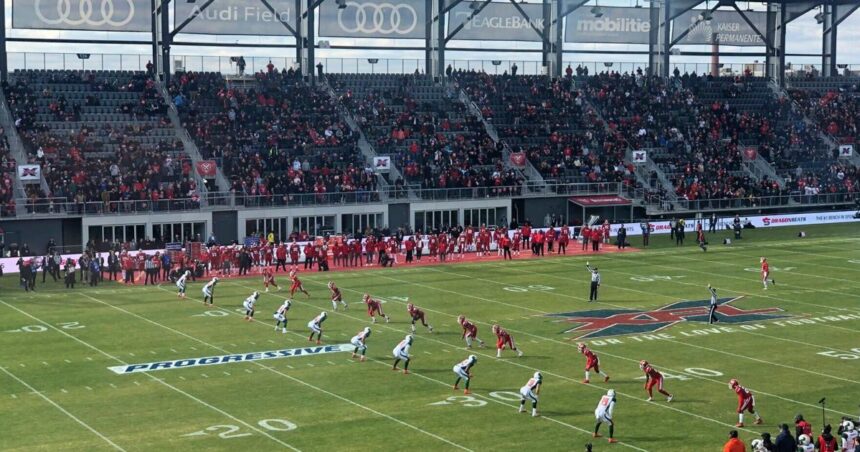With two decades in coaching, including 11 years in the NFL, Buffalo Bills special teams coordinator Matthew Smiley has developed a routine of leaving work behind and focusing on family once he leaves the office in Orchard Park.
However, the off-season presented a challenge as the new kickoff rule approved by league owners in March forced Smiley to immerse himself in strategy, diagrams, and on-field teaching during his commute.
Concerned about the amount of mental space this work was taking up, Smiley expressed his thoughts to The Buffalo News, saying, “An improper percentage.”
The D.C. Defenders, right, line up against the Seattle Dragons for the opening kickoff of the opening football game of the XFL season, Saturday, Feb. 8, 2020, in Washington.
The new rule aims to bring excitement back to kickoffs by encouraging more returns and adding an element of entertainment and intrigue to the play.
People are also reading…
The league hopes to see more big plays and touchdowns on kickoff returns with the new rule in place.
Previously, the touchback was a common result on kickoffs, but the new rule looks to change that dynamic and bring back the excitement of the return game.
This significant rule change is expected to have a similar impact as historical changes in the game, potentially leading to more action and excitement on kickoffs.
Coaches, players, and fans are anticipating a thrilling season ahead with the new kickoff rule in effect, aiming to make kickoff returns a key part of the game once again.
Smiley and his team are embracing the challenge of adapting to the new rule and are excited about the potential for more explosive plays on kickoffs this season.
Stay tuned as teams prepare for an exciting and action-packed kickoff experience in the upcoming NFL season.
Teaching the rule
Here’s a breakdown of the new kickoff rule:
Key points include the setup of both the kicking and receiving teams, the landing and setup zones, and the specific rules regarding kick placement and returns.
Players are adjusting to the new rule through video reviews, on-field walkthroughs, and practice sessions, gearing up for an exciting and dynamic kickoff experience.
Coaches and players are embracing the challenge of mastering the new rule and are excited about the potential for high-energy plays and increased excitement on kickoffs.
Stay tuned as teams experiment with different strategies and techniques to make the most of the new kickoff rule in the upcoming season.
Exciting times lie ahead as the NFL enters a new era of kickoff returns with the introduction of the new rule.
Don’t miss out on the thrilling action as teams aim to make the kickoff game a highlight of the season.
Be the first to witness the excitement as teams adapt and thrive under the new kickoff rule this NFL season.
Experimentation time
As coaches and players adjust to the new rule, they are experimenting with different strategies and techniques to optimize their performance on kickoffs.
Expect to see teams exploring various approaches in preseason games to fine-tune their kickoff strategies and maximize their chances of success.
Players are gearing up for a fast-paced and dynamic kickoff experience this season, with a focus on quick decision-making and execution on the field.
Stay tuned as teams adapt and innovate under the new kickoff rule, aiming to make kickoffs an exciting and impactful part of the game.
Exciting times lie ahead as teams embrace the challenge of mastering the new kickoff rule and strive for excellence in their performance.
Don’t miss out on the action as teams unleash their full potential under the new kickoff rule this NFL season.
NFL’s new kickoff rule stops players from running pre-kick, aiming to enhance game excitement. This will now fully bring back the value of the kick returner.
Declining returns
Over the past 20 years, the kick return play has seen a decline in its impact and frequency:
Category – 2003 – 2013 – 2023
Kick return touchdowns – 13 – 7 – 4
Teams with at least 50 returns – 32 – 5 – 0
Returns of at least 40 yards – 108 – 77 – 24
Kickoff rule 101
Here is an overview of the new kickoff rule to be implemented in the NFL on a trial basis:
- The kicking team must have 10 players lined up with their lead foot on the receiving team’s 40-yard line.
- The kicker will kick the football from his 35-yard line and can’t cross the 50-yard line until the ball hits the ground or is caught.
- The receiving team must have seven players lined up with their lead foot on their 35-yard line. They can have two players lined up outside the hash marks within 5 yards of the 35.
- All players in the setup zone can’t move until the football is either caught or hits the ground.
- The landing zone is the space between the receiving team’s 20-yard line and the goal line.
- If a kickoff falls in the landing zone, it must be returned. Fair catches are not permitted.
- A kickoff that lands short of the landing zone, is kicked out of bounds before the goal line or hits one of the receiving team’s nine players in the setup zone will result in the football being placed on the receiving team’s 40-yard line.
- A kickoff that hits the landing zone and then goes into the end zone can be returned or downed. If the football is downed for a touchback, the offense starts at the 20-yard line.
- A kickoff that goes through the end zone or bounces in the landing zone and goes through the back of the end zone is a touchback, and the receiving team will start at the 30-yard line.





